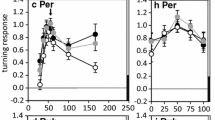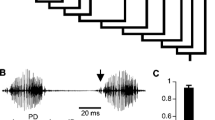Abstract
The phonotactic response of cricket females was investigated on a locomotion compensator to determine the temporal parameters of the male's calling song which are important for species recognition. Two sympatric species (Teleogryllus commodus, T. oceanicus) that show different syllable periods in the chirp and trill parts of their calling songs were used. By their responses T. commodus females exhibited two temporal filters for syllable periods, which were tuned to the species-specific syllable periods occurring during chirp and trill. For song recognition both filters had to be activated and for both a minimum number of three to five consecutive syllable periods was necessary. In contrast, T. oceanicus females showed only one sharply tuned filter corresponding to the chirp part of the male's calling song. This filter was sufficient for calling song recognition. Syllable periods of the trill part also influenced calling song recognition, but these played only a minor role. Carrier frequency was also important for positive phonotaxis. Calling song recognition by T. commodus females is largely based on central nervous processing, while for T. oceanicus both peripheral frequency filtering and central temporal filtering is important.
Similar content being viewed by others
Author information
Authors and Affiliations
Additional information
Accepted: 17 January 1997
Rights and permissions
About this article
Cite this article
Hennig, R., Weber, T. Filtering of temporal parameters of the calling song by cricket females of two closely related species: a behavioral analysis. J Comp Physiol A 180, 621–630 (1997). https://doi.org/10.1007/s003590050078
Issue Date:
DOI: https://doi.org/10.1007/s003590050078




